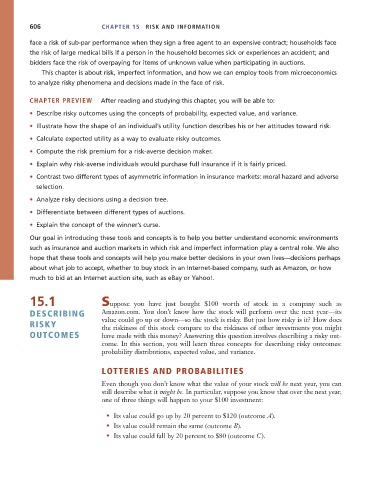Page 632 - Microeconomics, Fourth Edition
P. 632
c15riskandinformation.qxd 8/16/10 11:10 AM Page 606
606 CHAPTER 15 RISK AND INFORMATION
face a risk of sub-par performance when they sign a free agent to an expensive contract; households face
the risk of large medical bills if a person in the household becomes sick or experiences an accident; and
bidders face the risk of overpaying for items of unknown value when participating in auctions.
This chapter is about risk, imperfect information, and how we can employ tools from microeconomics
to analyze risky phenomena and decisions made in the face of risk.
CHAPTER PREVIEW After reading and studying this chapter, you will be able to:
• Describe risky outcomes using the concepts of probability, expected value, and variance.
• Illustrate how the shape of an individual’s utility function describes his or her attitudes toward risk.
• Calculate expected utility as a way to evaluate risky outcomes.
• Compute the risk premium for a risk-averse decision maker.
• Explain why risk-averse individuals would purchase full insurance if it is fairly priced.
• Contrast two different types of asymmetric information in insurance markets: moral hazard and adverse
selection.
• Analyze risky decisions using a decision tree.
• Differentiate between different types of auctions.
• Explain the concept of the winner’s curse.
Our goal in introducing these tools and concepts is to help you better understand economic environments
such as insurance and auction markets in which risk and imperfect information play a central role. We also
hope that these tools and concepts will help you make better decisions in your own lives—decisions perhaps
about what job to accept, whether to buy stock in an Internet-based company, such as Amazon, or how
much to bid at an Internet auction site, such as eBay or Yahoo!.
15.1 Suppose you have just bought $100 worth of stock in a company such as
DESCRIBING Amazon.com. You don’t know how the stock will perform over the next year—its
value could go up or down—so the stock is risky. But just how risky is it? How does
RISKY the riskiness of this stock compare to the riskiness of other investments you might
OUTCOMES have made with this money? Answering this question involves describing a risky out-
come. In this section, you will learn three concepts for describing risky outcomes:
probability distributions, expected value, and variance.
LOTTERIES AND PROBABILITIES
Even though you don’t know what the value of your stock will be next year, you can
still describe what it might be. In particular, suppose you know that over the next year,
one of three things will happen to your $100 investment:
• Its value could go up by 20 percent to $120 (outcome A).
• Its value could remain the same (outcome B).
• Its value could fall by 20 percent to $80 (outcome C).

